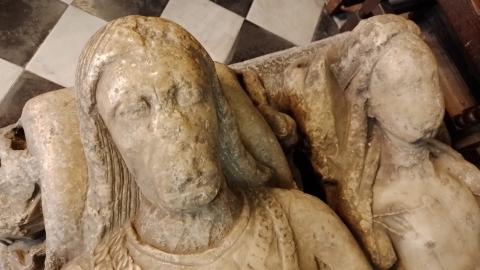Family Lessons 107: Married Cousins

My 17x great-grandparents, John Crosse and Joan Calcott, required special permission from John Kemp to marry each other. Kemp (or Kempe) had been, and was soon to become again, Lord Chancellor, but in 1449 he was merely Archbishop of York. He was accused of neglecting his northern province, preferring the machinations of court life, so I suspect that the permission for my forbears to marry was given by some official or agent rather than the prelate himself. In the archbishop’s name, therefore, a special dispensation was made that young Joan and John could wed, despite their being ‘twice related in the 4th degree’. This means they were first cousins, twice over. They evidently shared two sets of grandparents, which would normally render them too closely related to form a legally recognised union. Whether arguments were offered, or bags of silver, to persuade Archbishop Kemp’s office to grant permission, it is not clear.

Archbishop Kemp's tomb, Canterbury
My greatest frustration, and one with which any genealogical researcher will know too well, is that the family lines are incomplete, so I cannot tell which grandparents were shared. Joan is simply recorded as ‘daughter of Ric. Calcott of the City of Chester, gentleman’. I can find no record of his wife, nor of John’s mother, Margaret’s, surname. Nevertheless, that special permission, called a dispensation, was granted 26th July, 1449, the archbishop ‘citing a dispensation of Pope Nicholas V.’ Although I have failed to find that papal pearl, and refuse to pore through tomes of Roman canon law, it must have been recognised as legally valid, or some unscrupulous (or scrupulous) relative would have disputed the marriage and claimed the family property.
Scripture does not forbid the marrying of cousins in particular, but it certainly lists others from whom the people of God should not solicit intimacy. Leviticus 16 reads:
None of you shall approach to any that is near of kin to him, to uncover their nakedness: I am the Lord. The nakedness of thy father, or the nakedness of thy mother, shalt thou not uncover: she is thy mother; thou shalt not uncover her nakedness. The nakedness of thy father's wife shalt thou not uncover: it is thy father's nakedness. The nakedness of thy sister, the daughter of thy father, or daughter of thy mother, whether she be born at home, or born abroad, even their nakedness thou shalt not uncover.…and so on
European royalty, notably the Habsburgs, were notorious for interbreeding and for their offspring’s physical deformities. Much as I despise the late medieval church, its general aversion to consanguinity, to use its technical name, was probably wise. Charles Darwin of all people married his cousin, Emma Wedgwood (his mother’s brother’s daughter) and considered examples of ill-health among his children to have been caused by this, as well as its being the primary reason for 'idiocy' in the general population. A reaction against cousin marriage occurred in Britain after the Great War, and by the 1920s British eugenicists were regularly condemning it. Leonard Darwin, the son of Charles, followed his infamous cousin Francis Galton as President of the Eugenics Education Society, and worked against the practice. Perhaps these high priests of atheism were finally realising that scripture’s general proscription and the old Church’s more particular prohibition were wise afterall.
If John and Joan’s children or grandchildren were ill-affected by their unusually close genetic ties, the scant records offer little evidence. Scripture, though not Darwin and Galton I think, teaches that all people are descended from a defined, common ancestor, and that we are all cousins of some degree. Our DNA, however, is already corrupted and degenerating into further states of decay, whether we inbreed or not. One day, the family of God shall stand together around the Father’s throne in the Kingdom of His Son, though we shall then neither marry, nor be given in marriage.
- Log in to post comments


 Sunday Worship 10.45am & 6.00pm
Sunday Worship 10.45am & 6.00pm